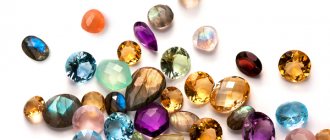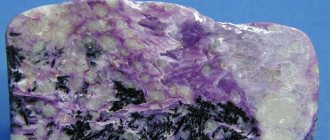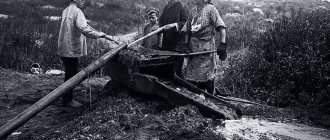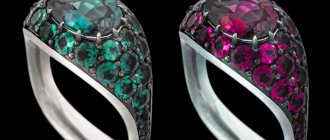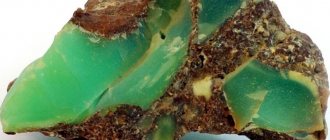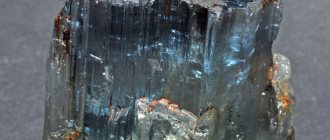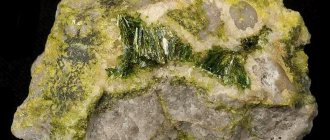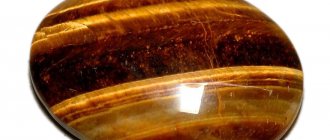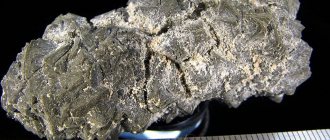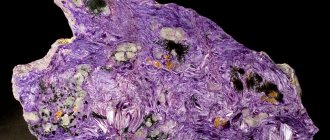Are you looking for a talisman? Then this article is for you! From it you will learn about the healing and magical properties of andalusite, and also understand how to care for your jewelry. We will tell you how to cleanse an amulet of negativity and which zodiac sign you can give such a gift to.
History and origin
Stones in the form of granular aggregates or rather large prismatic pillar crystals were first found in the southern part of sunny Spain and Andalusia and then described in 1798 by a geologist and mineralogist from France, Delameterrier.
The stone immediately attracted attention; it changed color depending on the lighting. This phenomenon is called pleochroism. The stone was in great demand by the Knights of the Order of Malta and Catholic monks due to another feature - when cut, a bright cross appeared inside it. Therefore, andalusite is often called the “Maltese cross” or cross stone.
Chemical composition of andalusite
Chemical theoretical composition: Al2O3 - 62.93, SiO2 - 37.07. Using the paramagnetic resonance method, it was established that Fe3+ mainly replaces Al in six-coordination, and Cr3+ replaces only Al in six-coordination; Se+ replaces Si4+; the role of Mn is not clear.
A spectroscopic study showed that on average andalusite contains (in%): Li - 0.021, Ga - 0.0083, Zr - 0.0045, V - 0.004, Cr - 0.002, B - 0.001 and traces of Ni, Sr, Y, Pb . According to Vershkovskaya et al., the Ga content in it does not exceed 0.001%. The mineral contains (in%): Zn - 0.02, Zr - 0.2, Cu - 0.04, Ni - 0.02, Sr - 0.03, Nb -0.01, Y - 0.02. The Ra content of andalusite from Japan is n-10-12.
Varieties of andalusite
Manganandalusite - manganandalusite. Synonym - viridine - viridine, gosseletite - gosseletite (Koren, 1934). It is distinguished by a high content of MnO (up to 19.22%) and sometimes contains more iron than ordinary andalusite (up to 6.6% Fe2O3). Observed in the form of short-prismatic, slightly flattened crystals (up to 20-40 mm), grains, round, columnar and plate-shaped clusters; monomineral isolations sometimes reach 150×70 mm. Color bright green, dark green (almost black). Optical (+). The grain elongation is positive. Intense pleochroism; The refractive index is higher than that of ordinary andalusite. Occurs in Mn- and Fe-bearing clayey sandstones, feldspathic sandstones, mixed clastic and tuffaceous sediments subjected to regional (low to medium-high degree) and contact (low degree) metamorphism, in hematite-bearing phyllites. Known in the Aldan Highlands in Yakutia, where its content in some places reaches 60%; on the river Timpton is associated with biotite, feldspars, sillimanite, almandine, rutile, chlorite, apatite, graphite, hematite, magnetite, amphibole, monoclinic pyroxene, bastite, cordierite, pyrrhotite, ilmenite; on the Okurdan char it is observed in association with quartz, manganophyllite, garnet (spessartine-pyrope), hematite, magnetite, microcline, oligoclase, as well as accessory rutile, monazite, zircon, apatite and svanbergite. In the Ultevis district in Northern Sweden it is found in quartzites and leptites; associated minerals: microcline, plagioclase, hematite, muscovite, apatite, epidote, tourmaline, zircon, piemontite; here it was found in pegmatites cutting leptites with quartz, microcline, pyroxene, and Mn-garnet. At Vestano in Southern Sweden, manganandalusite occurs in quartzites with muscovite and accessory zircon and garnet. In Darmstadt (Germany) in contact-metamorphic schists it is accompanied by quartz, piemontite, biotite and accessory apatite, rutile, garnet, and hematite. On Mount Kiev in pc. New Mexico (USA) manganandalusite is abundant in quartzites containing kyanite, muscovite, hematite, and less commonly rutile and zircon. At Salm-Château (Belgium), manganandalusite is represented by porphyroblasts in hematite-bearing phyllites. Manganandalusite is replaced by muscovite, a chloritoid, a mixture of chlorite with quartz and sericite with piedmontite, a clayey substance. When leached, Mn and Fe become discolored. In terms of interplanar spacing, manganandalusite does not differ from ordinary andalusite.
Crystals may trap carbonaceous or clayey material during growth. Its concentration occurs in certain crystallographic directions, resulting in the characteristic figure of a cross; this variety is called chiastolite (Greek “hiastos” - crossed, “cast” - stone). Dark core of chiastolite from Lancaster. Massachusetts (USA) consists of muscovite, chlorite, quartz, sulfides, oxides of iron and titanium.
Physical properties
| Property | Description |
| Formula | Al2SiO5 |
| Hardness | 7,5 |
| Density | 3.12—3.18 g/cm³ |
| Refractive index | 1,641—1,648 |
| Kink | Uneven, fragile |
| singonia | Rhombic |
| Cleavage | Imperfect |
| Shine | Glass |
| Transparency | Transparent |
| Color | Grey, yellow, brown, golden, orange-brown, pink, red, dark green or colorless |
The ability of the mineral to absorb rays heterogeneously, changing color, makes the stone exceptional - two colors can appear in one stone, creating the effect of diachronism (optical two-color). Even in constant light, the stone can shimmer with gray - purple, olive - green, pink - brown shades, which are caused by aluminum, iron, chromium and manganese that are part of it. The stone can be colorless (but this is very rare), transparent or translucent.
Classification
Andalusite in its structure has two types of aluminum atoms - in coordination 6 and 5. Non-ideal octahedra (octahedrons) consisting of a compound of aluminum and oxygen are parallel to the axis in the form of chains that are connected along the edges. Covalent bonding exceeds ionic bonding.
| IMA (International Mineralogical Association) status | Authorized, "Grandfathered" described before 1959 |
| Nickel-Struntz classification 10th edition (pending revision) | 9.AF.10 |
| Dana Classification 8th Edition - Primary Groups | 52.2.2b.152: Neosilicates precipitated by SiO4 groups and O,OH,F,H2O |
| Hey,s CIM Ref | 15.1 |
Crystallography
| Syngony (crystal type) | Rhombic (pseudo-tetragonal) |
| Class (HM) | mmm (2/m2/m2/m) – irregular pyramid |
| Space group | Pnnm |
| Unit cell volume | A=7.798(7) Å, b=7.9031(10) Å |
| Ratio | a:b:c: = 0.987:1:0.703 |
| Unit cell | V:342.44 Å3 |
| Duality | rare |
| Morphology (elements) | The elements are crystals and columnar compounds having almost square sections, usually elongated in parallel (up to 20 cm). Crystals may be interrupted due to interference with external minerals. |
Chemical composition
Anadalusite is a prismatic anhydrous crystal that is highly resistant to acids.
| Formula | Al2(SiO4)O |
| Formula (MMA - International Mineralogical Association) | Al2SiO5 |
Physical properties
Andalusite is considered a pure mineral that is common in clayey and coal-shale. Occasionally it is found in mica schists.
Transparent green andalusite is considered its most valuable form. Unlike other pleochraean gemstones, where gem cutters try to reduce the multi-colored tones and emphasize the best color, cutting andalusite instead tries to produce a good combination of colors.
| Shine | Vitreous, sub-vitreous, bold |
| Transparency | Transparent |
| Color | Pink, dark red, white, gray, green, yellow, sometimes purple |
| Mohs hardness | 6 ½ — 7 ½ |
| Series | white |
| Density | |
| Split | Excellent/good |
| Fracture | Irregular Subconchoidal |
| Density | 3.13 – 3.21 cm3 (according to measurement results), 3.149 g/cm3 (according to calculation results) |
| Perseverance | brittle |
Production (fields)
Mineral deposits are often not deep, on the mountain slopes of rivers. Since the discovery and description of the mineral, a large number of deposits have appeared in different countries of the world.
Findings of gem-quality crystals are quite rare. In addition to good examples still being mined in Spain, the Minas Geras and Espirito Santo placers in Brazil are considered promising deposits. Interest in them continues after the discovery of a very large and pure crystal weighing 75-100 carats, from which an excellent piece of jewelry was made.
Unique dark blue crystals have already been found in placers in India, Burma and Ceylon.
The most famous andalusite deposits are in the USA (California, Maine, Connecticut and New Mexico), Canada (Quebec), Australia and Russia (Nerchinsk).
Not long ago, crystals of excellent quality up to 20 cm in length were discovered in Uzbekistan.
Green veridite crystals are mined in Sweden, Spain, Austria and China. There have also been several finds of blue andalusite crystals in Belgium.
One of the famous andalusites is kept in Washington at the Smithsonian Museum. This is a brown crystal, weighing 28.3 carats, brought from Brazil.
Industrial mining of andalusite for the production of refractory materials exists in Italy, Germany, Sri Lanka and Brazil.
Featured in the Smithsonian's current public exhibition - Andalusite with quartz, muscovite and biotite.
Varieties of mineral
Andalusite is presented in three types:
- Chiastolite, or “cross stone,” is formed as a result of the combination of a mineral with clay and coal, and has a brownish-green tint. It is distinguished by the presence of a pattern on the surface that resembles a cross.
- Titanic andalusite is distinguished by the presence of titanium oxide in its composition, which gives the mineral a gray color, which sometimes shimmers with silver shades.
- Viridin is a mineral with a high content of iron and manganese inclusions, used in jewelry. In cross-section, the crystal has a greenish, “grassy” tint with light green (less often yellow) inclusions.
Also read: Beryl - the magical properties of the gemstone
TYPES AND COLORS OF ANDALUSITE
Among the andalusites suitable for jewelry processing, the following types of stone are distinguished:
| chiastolite |
|
| viridin (manganandalusite) |
|
Green andalusite
Few crystals suitable for jewelry processing are found; It is difficult to cut a stone.
Medicinal properties
For hundreds of years, healers have used andalusite in their practice. A talisman made from this stone, worn on the chest, is one of the best preventive and therapeutic agents for diseases of the respiratory system: bronchi, trachea, lungs. It is good especially for children and elderly people who do not want to be treated with antibiotics.
But the medicinal properties of the cross are not limited to this. It is known that the stone has a wonderful effect on the human psyche and nervous system: it calms, restores inner harmony, and helps to survive stress and shock.
And souvenir products from the “Maltese cross”, located within the walls of the house, increase the body’s resistance to disease and improve the functioning of the heart and blood vessels.
Place of Birth
Andalusite is mined in many countries.
The mining geography is so vast because this mineral lies shallow, it can even be found on the banks of mountain rivers. But these are mainly raw materials for technical purposes. Specimens suitable for jewelry making are rare. High-quality minerals are supplied to the world market from the Asian jewelry triangle: India, Myanmar, Sri Lanka.
Green crystals are mined in Sweden, Austria, China, Myanmar, blue crystals are mined in Belgium.
Andalusite deposits are also developed in the following countries:
- Australia;
- SOUTH AFRICA;
- Canada;
- USA;
- Brazil;
- Germany;
- Italy.
In Spain, the deposits are almost depleted.
In Russia, deposits of this stone are located in the Urals, Transbaikalia, and Elbrus region.
Read also : Lepidolite - a stone that protects from dangers
Magical powers
The stone has truly magical properties that were noticed back in the Middle Ages. Its strength is not inferior to the most expensive gems. Sorcerers use the cross to communicate with the other world, summon spirits and put them into a state of trance, meditation, and predict the future.
REFERENCE! It is known for sure that Nostradamus himself never parted with an andalusite amulet.
In magical circles, the cross is called the “Seeing Stone” - it helps to form the correct opinion about both a person and an event of the past or future.
The stone helps people with paranormal abilities to penetrate the secrets of the Universe, gain sacred knowledge, and reach a new level of spirituality.
Stone and name
First of all, andalusite, in its formation chreostalite and the colloquial name “cross”, is associated with the name Christina or Christian, which means dedicated to Christ.
The semantics of the word resembles rough, natural, without fake. People who bear such names can be artless and pure. Quite often, natural shyness can interfere with their frank relationships. Some of them may dedicate their lives entirely to important charitable missions.
The meaning of the stone for a person
Andalusite has enormous energy, perhaps due to its natural cross, which is capable of maintaining the integrity of the owner’s aura. The stone should be used by extroverts - people whose line of work is related to people and is aimed at providing assistance.
These are doctors, rescuers, priests, military (but in peacetime, soldiers are not recommended to wear a talisman ). The special influence of the cross on those who are associated with plants and animals is noted: gardeners, field farmers, veterinarians.
Use in treatment
Like all precious and semi-precious natural stones, andalusite has a positive effect on human health. The mineral is used in the treatment of such ailments:
- heart disease;
- blood pressure problems;
- nervous disorders;
- depression;
- dizziness;
- weak immunity;
- chronic fatigue;
- VSD;
- bronchitis;
- rhinitis;
- pharyngitis;
- angina;
- gout;
- arthritis;
- fungus;
- vision problems.
Compatibility with other stones
Since andalusite has great energy, it cannot be used in jewelry, talismans, or amulets together with precious stones that have the same energy (diamonds, rubies). Otherwise, jewelry will lose not only its beauty, but also its ability to positively influence a person. They will become useless.
This stone, thanks to its unusual beauty and magical power, is destined to be the center of any decoration. Therefore, there must be weaker minerals around it, capable of subordinating their strength to the Maltese cross. They can be Lapis Lazuli, Carnelian and Peridot.
Also read: Tektite – formed after the collision of the Earth and a meteorite
Interesting Facts ?
Beads, rings, and amulets are still made from chiastolite. They are in demand among believers and representatives of subcultures.
One of the colors of Andalusite, that is, yellowish, has been recognized as the most important healing stone.
The color and hardness of andalusite make it suitable for men's jewelry.
Andalusite is considered to be a stone that has some mystical properties; hence, it is used as a talisman against the evil eye.
Andalusite becomes a powerful stone when used in combination with natural diamonds and citrine.
To benefit from the healing properties of andalusite, it should be worn directly on the skin or held in the hand.
Kiastolite is considered the most precious form of andalusite stone.
The ancient Greeks used these extravagant crystals for medicinal and decorative purposes.
When cutting, a good jeweler will try to ensure that the pleochroism of the stone is most clearly revealed.
Jewelry with mineral
The mineral is processed differently depending on its color, transparency and cross-shaped pattern, which is why the jewelry is made differently.
- If a cross is observed in the stone, then it is not cut, but only polished, creating cabochons (translated from French as “heads”). They are widely used in massive men's rings, amulets, and as a central stone in necklaces.
- Very rare transparent andalusites are cut - such stones are beautiful in rings and earrings.
- Round, oval and teardrop-shaped stone cuts are most common, but such jewelry has a fairly high price - $15-25 per carat (the smallest cut andalusite is at least 5 carats).
- High-quality pink-green and pleochroic andalusites from Brazil are highly prized, starting at $250 per carat.
You can buy jewelry with the Maltese cross in jewelry stores and on the Internet.
A faceted stone without a frame costs from 800 to 2,750 rubles, earrings with a cross inside the stone - from 2,700 to 5,000 rubles, bracelets - from 5,600 rubles, pendants and rings (depending on the size of the stone) - from 2,500 rubles. You can also find beads on sale, but the stones in them are often small and the cost is quite high.
Form of being in nature
The appearance of crystals . Columnar with a square section, compressed, elongated prismatic.
Doubles of (101) are rare. Inclusions consist of gas-liquid segregations, carbonaceous and clayey matter, quartz, rutile, garnet, corundum, and zircon. In the cross section of the crystals of the so-called chiastolite, inclusions of carbonaceous or clayey matter look like a dark cross, rhombus or checkerboard cells, in the longitudinal section - dark stripes on white or gray
Aggregates. Crystals, grains, fibers; aggregates of grains, sometimes radiant, columnar, columnar deposits. The length of individual crystals reaches 10-15 cm or more; The largest crystal (61 cm in length and 15.24 cm in width) was found in a pegmatite vein of Batista Canyon in the state. California (USA).
How to distinguish from a fake?
The authenticity of a stone is determined based on its features:
- The ability to change color (pleochroism) is tested simply: you need to rotate the stone, and, regardless of the lighting, the color of the stone will change.
- Knowing that andalusite is a very hard mineral, you can run it across the glass. The scratch will remain on the glass - the surface of the cross will be intact.
- Features of the internal pattern also make it possible to determine the authenticity of the stone. A careful examination with a magnifying glass in a real stone will reveal a symmetrical pattern with a transition from dark brown stripes to lighter ones.
How to care
Caring for this gem is easy:
- The main thing is to protect it from falls and impacts, otherwise chips and cracks may appear.
- Contaminants should be washed off with running water at room temperature, or with neutral soap. Dry with a soft cloth.
- Do not use aggressive household chemicals to clean the stone.
- Protect from high and low temperatures, store away from heating devices, in a box or casket.
- Keep away from bright sun to preserve its color.
- To clean the metal mounting of the stone, it is better to take it to a jewelry workshop once a year.
To recharge andalusite energetically, it must be placed under the light of the full moon. During the full moon, the stone is effectively recharged. On the new moon - it is cleansed of the negative energy that it took upon itself, protecting the owner from magical influences from the outside.
Caring for stone products
In modern jewelry, they offer special chemical solutions for cleaning jewelry and souvenirs made of precious stones and metals. But we must remember that stones do not tolerate even mild chemical exposure.
Also read: Diamond – a stone of hidden luxury and material wealth
Andalusite is a very durable stone, but it remains a natural material. Therefore, it is better to care for it in a simple way: take the cheapest laundry soap without additives, make a soap solution and use a soft brush to clean the jewelry with light movements, then blot with a cloth or paper towel and dry.
IMPORTANT! Andalusite should not be stored in direct sunlight.
Compatibility with zodiac signs
(“+++” – the stone fits perfectly, “+” – can be worn, “-” – is strictly contraindicated):
| Zodiac sign | Compatibility |
| Aries | + |
| Taurus | + |
| Twins | +++ |
| Cancer | + |
| a lion | + |
| Virgo | +++ |
| Scales | +++ |
| Scorpion | + |
| Sagittarius | + |
| Capricorn | + |
| Aquarius | + |
| Fish | +++ |
The natural material is associated with the constellation Virgo. It is considered to be universal in astrological terms - it can be used by all signs of the zodiac.
But most of all the stone is suitable for Libra, Gemini and Pisces. He especially protects them, strengthens their health, and brings them into a state of harmony.
There are no contraindications to the use of semi-precious stone.
Is this stone right for you?
REFERENCE! The Maltese cross is consistent with the number 7, which is the sum of two divine numbers: 3 and 4.
Helpful information
- Due to its high heat resistance, the stone is widely used for refractory lining.
- Sand obtained after processing stone is used to produce dishes, furniture, and spark plug elements. They are absolutely safe at high temperatures.
- The stone is called "the poor man's alexandrite", but it changes color regardless of the light.
Andalusite, Maltese cross, cross, “Seeing Stone”... Whatever you call it, we are talking about an amazing mineral given to humanity as a talisman. But we must remember: he will help only those who are pure in soul and have no evil intentions.
5/5 — (1 vote)
